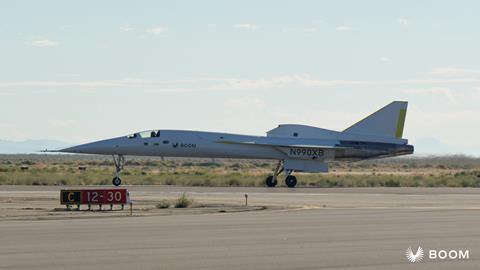The Federal Aviation Administration has taken a step toward approving Boom Supersonic to complete supersonic test flights using its XB-1 demonstrator, but the agency’s green light remains outstanding.
The FAA this week released an environmental assessment addressing possible impacts of Boom’s planned supersonic flight-test programme.
The 79-page document, dated 9 January, describes the flight tests as having minimal environmental impact, considering the supersonic flights are to be conducted within airspace corridors already widely used by the military for ultra-fast flights.
Boom has for several years said it was close to getting XB-1 airborne for the first time, though its targets have come and gone without the jet flying. Recently, Boom has predicted first flight will occur in “early 2024.”

The company intends to use XB-1 to evaluate designs and technology as part of its development of a conceptual supersonic passenger airliner called Overture.
Boom in 2023 received an airworthiness certification from the FAA for XB-1.
Because US rules prohibit supersonic flight of civilian aircraft, Boom needs a “special flight authorisation” from the FAA before flying XB-1 at supersonic speed. The waiver approval process requires the FAA complete an environmental impact study.
“The FAA is evaluating Boom’s request for a special flight authorisation,” the agency says in a regulatory notice released on 11 January.
The FAA’s newly released environmental assessment provides details about Boom’s planned XB-1 flight tests. The company expects the test programme will include 10-20 flights at supersonic speed, and the FAA’s waiver would be valid for one year, the assessment says.
Boom will operate XB-1 from Mojave Air & Space Port in California and perform supersonic flights at altitudes of at least 30,000ft in two regions of airspace over California, both within an area managed by the US military. Those regions include the “Black Mountain Supersonic Corridor” and the “High-Altitude Supersonic Corridor”.
“The XB-1 demonstrator aircraft will test design features and operations, develop technologies and validate tools that aid in reducing later risks associated with the ultimate/final aircraft design,” says the FAA’s assessment. “XB-1 would serve as a flying data collector; a massive data acquisition system is integrated into the airplane.”
“This would enable the development of a safe, airworthy design for the company’s full-size supersonic airliner aircraft, Overture,” adds the document. The FAA is accepting public comments about the assessment through 2 February.

XB-1 is powered by triple GE Aerospace J85-15 turbojets – part of an engine family that entered service in 1959 and powers US Air Force Northrop T-38 Talon supersonic jet trainers. Boom intends to use a T-38 or a Northrop F-5 as a chase aircraft during flight tests.
Boom rolled out XB-1 in October 2020, saying at the time that it intended for XB-1 to make first flight in 2021. Then in 2021, Boom chief executive Blake Scholl said the milestone might not occur until 2022.
Major questions about Boom’s project remain open, including about the engines intended to power its conceptual Overture airliner.
In 2022, several aircraft engine makers – including Rolls-Royce, which had started working with Boom – said they were not interested in the project. Some of the companies cited concern about carbon emissions. Supersonic aircraft emit more carbon per seat than conventionally powered jets, according to reports.
Late in 2022, Boom said it picked a trio of suppliers to help develop a new engine, called Symphony, for Overture. Those partners include GE Additive, StandardAero and FTT, a business unit of Kratos Defense & Security Solutions. Boom is leading development of the powerplant.
Overture is to have four Symphony engines, fly at Mach 1.7, carry 64-80 passengers and have 4,250nm (7,871km) of range, according to Boom.


























